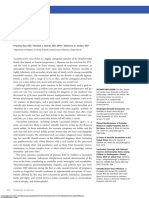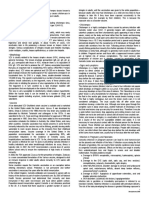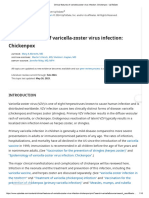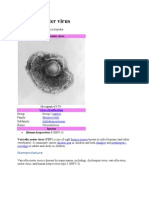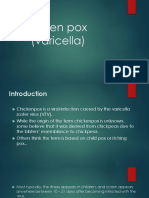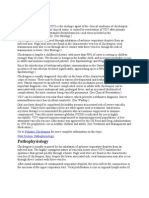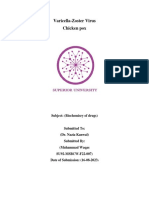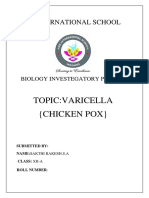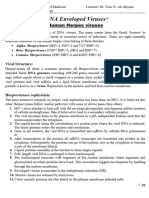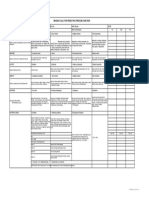0 ratings0% found this document useful (0 votes)
167 viewsVaricella Vaccine: Clinical Description
Varicella Vaccine: Clinical Description
Uploaded by
Arturo XadoThis section discusses the varicella-zoster virus (VZV) which causes chickenpox (varicella) and shingles (herpes zoster). It describes the clinical presentation of varicella including symptoms and rash appearance. It also discusses varicella in immunocompetent individuals versus immunocompromised individuals. Finally, it provides some historical context on the identification and characterization of the VZV.
Copyright:
© All Rights Reserved
Available Formats
Download as PDF, TXT or read online from Scribd
Varicella Vaccine: Clinical Description
Varicella Vaccine: Clinical Description
Uploaded by
Arturo Xado0 ratings0% found this document useful (0 votes)
167 views1 pageThis section discusses the varicella-zoster virus (VZV) which causes chickenpox (varicella) and shingles (herpes zoster). It describes the clinical presentation of varicella including symptoms and rash appearance. It also discusses varicella in immunocompetent individuals versus immunocompromised individuals. Finally, it provides some historical context on the identification and characterization of the VZV.
Original Description:
uhm
Original Title
Science
Copyright
© © All Rights Reserved
Available Formats
PDF, TXT or read online from Scribd
Share this document
Did you find this document useful?
Is this content inappropriate?
This section discusses the varicella-zoster virus (VZV) which causes chickenpox (varicella) and shingles (herpes zoster). It describes the clinical presentation of varicella including symptoms and rash appearance. It also discusses varicella in immunocompetent individuals versus immunocompromised individuals. Finally, it provides some historical context on the identification and characterization of the VZV.
Copyright:
© All Rights Reserved
Available Formats
Download as PDF, TXT or read online from Scribd
Download as pdf or txt
0 ratings0% found this document useful (0 votes)
167 views1 pageVaricella Vaccine: Clinical Description
Varicella Vaccine: Clinical Description
Uploaded by
Arturo XadoThis section discusses the varicella-zoster virus (VZV) which causes chickenpox (varicella) and shingles (herpes zoster). It describes the clinical presentation of varicella including symptoms and rash appearance. It also discusses varicella in immunocompetent individuals versus immunocompromised individuals. Finally, it provides some historical context on the identification and characterization of the VZV.
Copyright:
© All Rights Reserved
Available Formats
Download as PDF, TXT or read online from Scribd
Download as pdf or txt
You are on page 1of 1
SECTION TWO: Licensed vaccines
37
Varicella vaccine
Anne A. Gershon
Michiaki Takahashi
Jane F. Seward
The varicella-zoster virus (VZV) causes two diseases, vari-
cella (chickenpox) and herpes zoster (HZ, shingles). Infection Clinical description
with VZV (varicella) in temperate climates where vaccina-
tion is not used approaches 100% by the fourth decade of
life. Whereas varicella may be mild in some people, epidemi- Varicella (chickenpox)
ologic studies indicate that there is significant morbidity and
VZV is transmitted by the airborne route.1517 Although less
some mortality with primary infection in previously healthy
readily transmitted than measles, it is highly contagious, with
persons. The live attenuated varicella vaccine (Oka strain)
secondary attack rates in susceptible household contacts rang-
was developed by Takahashi in 1974,1 and it was licensed
ing from 61% to 100%.1821 VZV also can be transmitted to
in Japan in 1986. Varicella vaccine was licensed for routine
susceptible persons from patients with HZ, although studies
use in childhood in the United States in 1995. Monovalent
suggest that the risk of viral transmission is considerably less
varicella vaccines are licensed and available throughout the
from HZ than from varicella. In a household study, 16% of
world for the prevention of infection in healthy children,
71 susceptible children younger than 15 years exposed to HZ
adolescents, and adults. Combination vaccines for the pre-
developed varicella, a risk approximately five times lower than
vention of measles, mumps, rubella, and varicella were
that from varicella.22 In a small day-care study, a 3-year-old with
licensed in the United States in 2005. Progress has been
HZ transmitted varicella to about 30% of susceptible children.23
made in understanding the pathogenesis of HZ, and a large
collaborative clinical trial has demonstrated the effective-
Immunocompetent children and adults
ness of vaccination of the elderly for preventing HZ and its
major complication, postherpetic neuralgia. All VZV vac- Patients with varicella typically have a generalized vesicular rash
cines available worldwide are the Oka strain; the vaccine concentrated on the head and trunk, and fever. In the immu-
used to prevent zoster contains at least 14 times the amount nocompetent person, malaise and fever may occur 1 or 2 days
of virus as the vaccine to prevent varicella.2 This chapter before rash onset, but more commonly these symptoms occur
focuses on varicella vaccine; a later chapter discusses zoster concurrently with the appearance of the rash, a major differenti-
vaccine. ating feature from smallpox (Figure 37-1).2426 The rash appears
in crops; each crop usually progresses within less than 24 hours
from macules to papules, vesicles, pustules, and finally crusts.
New lesions occur in crops over the next few days, with various
Historical aspects stages of healing. The lesions are pruritic and may scar.
The average number of skin vesicles ranges from 250 to
Historically, varicella and smallpox were often confused; in 500 in otherwise healthy children.20,27 The height of the fever
1767, Heberden clinically differentiated them. Numerous stud- usually parallels the extent of rash, and the subject is usually
ies followed in which investigators induced varicella in volun- ill for 5 to 7 days. The rash has a central distribution, with a
teers by inoculation with vesicular fluid or exposure to patients concentration of lesions on the trunk, scalp, and face. Second
with either varicella or HZ. They showed that varicella is an cases of varicella can occur in immunocompetent persons, but
infectious disease (1875),3 the two diseases are caused by the their incidence is unknown.2832 It is hypothesized that the avid-
same agent,46 and HZ is probably the result of reactivation of ity of VZV antibodies is lower in persons who develop second
an agent acquired earlier in life.7 The virus was isolated in cell cases than in those who do not.31 Another possibility is that
culture by Weller and Stoddard in 1952,8 from vesicular fluid VZV temporarily subverts the immune system by immune eva-
from varicella patients. Later studies indicated that the viruses sion.3335 Subclinical reinfection with VZV also occurs.3638
isolated from subjects with varicella and HZ are morpholog- Varicella in otherwise healthy children is usually not severe,
ically and serologically identical, and the virus was named but the disease has a wide variety of infrequent extracutaneous
VZV.911 manifestations or complications.39 These include pneumonia,
Molecular studies showed the restriction endonuclease pat- encephalitis, cerebellar ataxia, arthritis, appendicitis, hepa-
terns of viral genomes from subjects with varicella and subse- titis, glomerulonephritis, pericarditis, and orchitis.4043 The
quent HZ,12 as well from vaccine recipients with subsequent most common complication in children is secondary bacterial
HZ,13,14 to be identical, proving that HZ is caused by reactiva- infection.40,42 Staphylococci or group A beta-hemolytic strepto-
tion of latent VZV. cocci are the usual causative pathogens. Group A streptococcal
You might also like
- Safety Education: Disaster Preparedness and Basic First AidDocument69 pagesSafety Education: Disaster Preparedness and Basic First AidKatrine Olga Ramones-CastilloNo ratings yet
- Varicella in BriefDocument3 pagesVaricella in BriefmacedovendezuNo ratings yet
- CASE STUDY - Docx Maam AlapDocument7 pagesCASE STUDY - Docx Maam AlapSam Aquino IINo ratings yet
- Herpes Zoster a Review of Clinical Manifestations and ManagementDocument13 pagesHerpes Zoster a Review of Clinical Manifestations and ManagementHasan AlmuwaffaqNo ratings yet
- Herpes Zoster Overview: Natural History and Incidence: Bethany A. Weaver, DO, MPHDocument5 pagesHerpes Zoster Overview: Natural History and Incidence: Bethany A. Weaver, DO, MPHRobbyNo ratings yet
- Martinon TorresDocument4 pagesMartinon TorresFiqha RosaNo ratings yet
- Varicella, Meningitis and DHFDocument7 pagesVaricella, Meningitis and DHFdebaynNo ratings yet
- 2018 Varicella-Zoster Virus InfectionDocument11 pages2018 Varicella-Zoster Virus Infectioneva yustianaNo ratings yet
- Varicella/Herpes Zoster: Communicable Disease Management ProtocolDocument5 pagesVaricella/Herpes Zoster: Communicable Disease Management Protocolyuliyanto.efendiNo ratings yet
- Clinical Features of Varicella-Zoster Virus Infection - Chickenpox - UpToDateDocument16 pagesClinical Features of Varicella-Zoster Virus Infection - Chickenpox - UpToDatevotuyetdongtrinhNo ratings yet
- Clinical features of varicella-zoster virus infection: Chickenpox - UpToDateDocument17 pagesClinical features of varicella-zoster virus infection: Chickenpox - UpToDateiuliaNo ratings yet
- WHO SurveillanceVaccinePreventable 22 Varicella R2Document12 pagesWHO SurveillanceVaccinePreventable 22 Varicella R2ErmiNo ratings yet
- Molecules 26 01132Document34 pagesMolecules 26 01132gd4f8dhkhhNo ratings yet
- Herpes Zoster: Shingles Acute Posterior GanglionitisDocument23 pagesHerpes Zoster: Shingles Acute Posterior GanglionitisHannah Clarisse Monge IgniNo ratings yet
- Home Visual Library Resources News Resources Mobile Subscribe Contact Skip To Main Page ContentDocument50 pagesHome Visual Library Resources News Resources Mobile Subscribe Contact Skip To Main Page ContentAnastasia Lilian SuryajayaNo ratings yet
- Indonesian VaricellaDocument18 pagesIndonesian VaricellaWahyu FathurrachmanNo ratings yet
- VariselaDocument5 pagesVariselaalrisimanungkalit27No ratings yet
- Varicella Zoster VirusDocument3 pagesVaricella Zoster VirusjojecoyocaNo ratings yet
- Viruses: Clinical Features of Varicella-Zoster Virus InfectionDocument11 pagesViruses: Clinical Features of Varicella-Zoster Virus InfectionBobby S PromondoNo ratings yet
- Varicella Zoster Virus: Two Lives of A Pathogen: Clinical ReviewDocument5 pagesVaricella Zoster Virus: Two Lives of A Pathogen: Clinical ReviewVICKI ANDREANNo ratings yet
- Varicella Zoster Virus Infection: July 2015Document19 pagesVaricella Zoster Virus Infection: July 2015nickNo ratings yet
- DR OwowoDocument34 pagesDR Owowohezekiahjoshua02No ratings yet
- Chickenpox (Varicella) For Healthcare Professionals CDCDocument1 pageChickenpox (Varicella) For Healthcare Professionals CDClaucavalcanteNo ratings yet
- Virology Lecture 7 Viral DiseseDocument21 pagesVirology Lecture 7 Viral Diseseao868598No ratings yet
- VaricellaDocument4 pagesVaricellasingcojericho11No ratings yet
- Nonpolio EnterovirusesDocument8 pagesNonpolio EnterovirusesAdrian Floyd PatalinjugNo ratings yet
- 22 Varicella Pink BookDocument24 pages22 Varicella Pink BookMohamad Syaikhul IslamNo ratings yet
- Expert Rev Vaccines. 2017 August 16 (8) 833-843Document21 pagesExpert Rev Vaccines. 2017 August 16 (8) 833-843cdsaludNo ratings yet
- Varicella Zoster Virus Vaccines An UpdateDocument15 pagesVaricella Zoster Virus Vaccines An UpdateAngelica CobosNo ratings yet
- AkhdakaaaaaknuqmakaakddaDocument12 pagesAkhdakaaaaaknuqmakaakddaVICKI ANDREANNo ratings yet
- Fwd. Epi 8Document40 pagesFwd. Epi 8Sumayya ChughtaiNo ratings yet
- The Association Between Varicella Vaccination and Herpes Zoster in Children A Semi-National Retrospective StudyDocument13 pagesThe Association Between Varicella Vaccination and Herpes Zoster in Children A Semi-National Retrospective Studydianindra555No ratings yet
- Varicella/Herpes Zoster: Communicable Disease Management ProtocolDocument0 pagesVaricella/Herpes Zoster: Communicable Disease Management ProtocolJohn StenlyNo ratings yet
- Acute Appendicitis As A Complication of Varicella: Case ReportDocument3 pagesAcute Appendicitis As A Complication of Varicella: Case ReportAngel AdileNo ratings yet
- Advances and Perspectives in The Management of Varicella-Zoster VirusDocument69 pagesAdvances and Perspectives in The Management of Varicella-Zoster VirusCitra Annisa FitriNo ratings yet
- Vaccinated Persons: Other Typical Symptoms That May Begin To Appear 1-2 Days Before Rash IncludeDocument5 pagesVaccinated Persons: Other Typical Symptoms That May Begin To Appear 1-2 Days Before Rash IncludePrimita Ayu DamayantiNo ratings yet
- Pinkbook: Herpes Zoster - CDCDocument8 pagesPinkbook: Herpes Zoster - CDCRezza PratamaNo ratings yet
- Herpes Zoster in an Immunocompetent Child without a History of VaricellaDocument6 pagesHerpes Zoster in an Immunocompetent Child without a History of VaricellaHasan AlmuwaffaqNo ratings yet
- Background: Pediatric Chickenpox Next Section: PathophysiologyDocument12 pagesBackground: Pediatric Chickenpox Next Section: PathophysiologyRachel Johann Aquinto100% (1)
- Presentation and Management of Herpes Zoster (Shingles) in The Geriatric PopulationDocument9 pagesPresentation and Management of Herpes Zoster (Shingles) in The Geriatric PopulationGrace Febryanti TodingNo ratings yet
- Chickenpox and SmallpoxDocument28 pagesChickenpox and SmallpoxFourth YearNo ratings yet
- Chapter 17: Varicella: I. Disease DescriptionDocument17 pagesChapter 17: Varicella: I. Disease DescriptionMihaiLNo ratings yet
- Fitzpatrick - S Dermatology in General Medicine 9th Ed. 2-2Document24 pagesFitzpatrick - S Dermatology in General Medicine 9th Ed. 2-2afeefaNo ratings yet
- Varicella NeonatalDocument5 pagesVaricella NeonatalTias FirdayantiNo ratings yet
- Infect Dis Clin. North Am. 2017Document18 pagesInfect Dis Clin. North Am. 2017cdsaludNo ratings yet
- Respiratory Virus InfectionsDocument9 pagesRespiratory Virus InfectionsChawki MokademNo ratings yet
- VirusDocument51 pagesVirusBatool SherbiniNo ratings yet
- Nejm Herpes ZosterDocument7 pagesNejm Herpes ZosterAlexander TegarNo ratings yet
- A151218DG WH EditedDocument2 pagesA151218DG WH EditedVivian ImadiyiNo ratings yet
- (ANDREWS) Herpes, Varicella, Shingles PDFDocument19 pages(ANDREWS) Herpes, Varicella, Shingles PDFmpsoletaNo ratings yet
- PR2 RRLDocument9 pagesPR2 RRLkrishnu VNo ratings yet
- Nihms 208518 PDFDocument12 pagesNihms 208518 PDFAhmad Tsaqib RamadhanNo ratings yet
- Chicken PoxDocument15 pagesChicken PoxQareeb KhanNo ratings yet
- This Is A Document About Chicken PoxDocument24 pagesThis Is A Document About Chicken Poxarul100% (1)
- Disease X, Re-Emerging Viral and Bacterial Pathogens: Another Deadly Pandemic Looming Ahead-A Mini ReviewDocument5 pagesDisease X, Re-Emerging Viral and Bacterial Pathogens: Another Deadly Pandemic Looming Ahead-A Mini Reviewduarte.pheNo ratings yet
- Epidemiology, Clinical Manifestations, and Diagnosis of Herpes Zoster PDFDocument34 pagesEpidemiology, Clinical Manifestations, and Diagnosis of Herpes Zoster PDFNehemiah FranciscoNo ratings yet
- Measles: Not Just A Childhood Rash: ReviewDocument7 pagesMeasles: Not Just A Childhood Rash: ReviewAyuNo ratings yet
- DNA Enveloped Viruses 2Document13 pagesDNA Enveloped Viruses 2Tamara ElyasNo ratings yet
- Vaccinated: From Cowpox to mRNA, the Remarkable Story of VaccinesFrom EverandVaccinated: From Cowpox to mRNA, the Remarkable Story of VaccinesRating: 4 out of 5 stars4/5 (41)
- Ulserasi Vesikobulosa Sederhana-Blok 11 FK 3Document229 pagesUlserasi Vesikobulosa Sederhana-Blok 11 FK 3sitiumaiyahNo ratings yet
- Testing Grid: Preanesthesia Assessment GuidelinesDocument2 pagesTesting Grid: Preanesthesia Assessment GuidelinesDian IkhwaniNo ratings yet
- Cognitive and PsychologicalDocument23 pagesCognitive and PsychologicalIsabel ValdésNo ratings yet
- Berra 2020Document12 pagesBerra 2020Indri AswariNo ratings yet
- Urinary Incontinence in Older Adults.25Document6 pagesUrinary Incontinence in Older Adults.25citraNo ratings yet
- Chapter 41: Nursing Management: ObesityDocument2 pagesChapter 41: Nursing Management: ObesityPrince K. TaileyNo ratings yet
- Health Teaching Plan: School of Health Care ProfessionsDocument6 pagesHealth Teaching Plan: School of Health Care ProfessionsGian Antonio GuidicelliNo ratings yet
- Keys Shah - SCI CW Genetics Project Research 114 - 15721804Document3 pagesKeys Shah - SCI CW Genetics Project Research 114 - 15721804keysha31No ratings yet
- Hyperthyroidism in PregnancyDocument3 pagesHyperthyroidism in PregnancyroyNo ratings yet
- CBT TestQ5Document3 pagesCBT TestQ5Roxane de Jesus100% (1)
- Psychiatry: MedpgnotesDocument54 pagesPsychiatry: MedpgnotesShanmugam BalasubramaniamNo ratings yet
- Abc of Wound Healing PDFDocument5 pagesAbc of Wound Healing PDF213942 Mohammed TotanawalaNo ratings yet
- 1st QTR Assesment MAPEHDocument5 pages1st QTR Assesment MAPEHNeriliza Dela CenaNo ratings yet
- Nephrology ProtocolDocument28 pagesNephrology ProtocolmahmoudNo ratings yet
- Micropara 1Document8 pagesMicropara 1Jing DelfinNo ratings yet
- Fruits and Vegetable ChartDocument3 pagesFruits and Vegetable ChartmorrienteskNo ratings yet
- CDC Birth Control ChartDocument2 pagesCDC Birth Control ChartCaitlin StrohlNo ratings yet
- Management of Chronic Diarrhea in Primary Care PDFDocument7 pagesManagement of Chronic Diarrhea in Primary Care PDFnaryNo ratings yet
- Blood TransfusionDocument8 pagesBlood TransfusionAlthea AlcalaNo ratings yet
- Infectious Diseases I 2024Document54 pagesInfectious Diseases I 2024saynow111No ratings yet
- Nurses Notes: General Santos Doctors' Hospital, IncDocument5 pagesNurses Notes: General Santos Doctors' Hospital, IncFran LanNo ratings yet
- 5605 Nursing DiagnosesDocument51 pages5605 Nursing Diagnoseseericalex100% (2)
- 1 Bjs 10662Document8 pages1 Bjs 10662Vu Duy KienNo ratings yet
- Treponema Pallidum: Transplacental (Intrauterin)Document2 pagesTreponema Pallidum: Transplacental (Intrauterin)Tovin NguyenNo ratings yet
- Nursing Care Plan: Cues Nursing Diagnosi S Analysis GOAL and Objectives Intervention Rationale EvaluationDocument5 pagesNursing Care Plan: Cues Nursing Diagnosi S Analysis GOAL and Objectives Intervention Rationale EvaluationMark Allison BuenaventuraNo ratings yet
- 2015 - October - PD Mind and Memory With FlyersDocument53 pages2015 - October - PD Mind and Memory With Flyersapi-280025964No ratings yet
- Braden Pressure Ulcer Risk AssessmentDocument1 pageBraden Pressure Ulcer Risk AssessmentNatasha BhasinNo ratings yet
- PERBEDAAN KWASHIORKOR Dan MARASMUSDocument3 pagesPERBEDAAN KWASHIORKOR Dan MARASMUSMathali' MonesiaNo ratings yet
- Medical-Surgical Nursing Assessment and Management of Clinical Problems 9e Chapter 13Document3 pagesMedical-Surgical Nursing Assessment and Management of Clinical Problems 9e Chapter 13sarasjunkNo ratings yet

